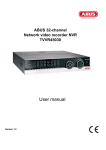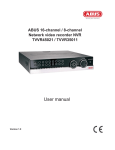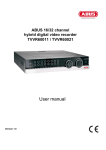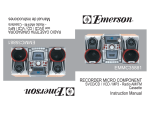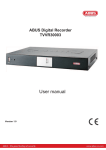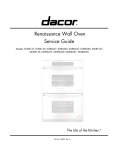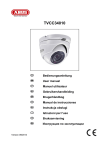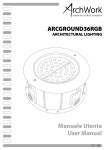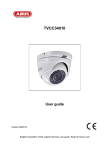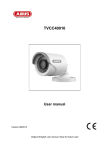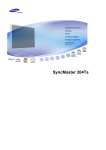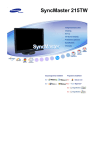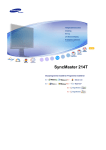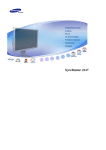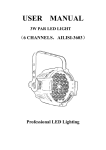Download User guide
Transcript
ABUS 4-channel digital recorder TVVR30004 User guide Version 1.0 English This user guide contains important information on starting operation and using the device. Make sure that this user guide is handed over when the product is given to other persons. Keep this user guide to consult later. A list of contents with the corresponding page number can be found in the index. 59 Device overview Device overview Rearside LED illumination 60 System operation System operation General information The device can be controlled as follows: Using the USB mouse Connections on the rear of the device Note Pay attention to the overview on page 60. No. 1 Name Function VIDEO IN: BNC video inputs 2 VIDEO OUT: BNC video output 3 BNC plug for video output to connect to a monitor as an alternative to VGA output (No. 3) VGA: 4 VGA monitor connection (9-pin), video output signal LAN: 5 Ethernet LAN connection USB: 6 USB connections for operating with a mouse and data export Power IN: 61 12 V DC System operation Mouse operation Note Further descriptions in these operating instructions are made with the mouse. The device is suitable for use with a USB mouse. Connect the mouse to the USB port. Button Function Left Single-click: Selection in the menu, activation of an input field or a TAB, display of the Quick Set menu Double-click: Switches between the screen display of single and multiple images in the live view and during playback Click and drag: Right In PTZ mode: Camera control Set-up of alarm areas or zones Single-click: Calls up the pop-up menu Scroll In the live view: wheel Shows previous / next camera In menus: Scrolls through the menus 62 Contents Device overview .............................................................................................................................................................60 System operation ...........................................................................................................................................................61 General information .......................................................................................................................................................61 Connections on the rear of the device ...........................................................................................................................61 Mouse operation ............................................................................................................................................................62 Quick guide.....................................................................................................................................................................66 Before you start ..............................................................................................................................................................66 Installing the HDD ..........................................................................................................................................................66 Establishing the connections .........................................................................................................................................66 Configuring the device ...................................................................................................................................................66 Important safety information ........................................................................................................................................67 Explanation of symbols ..................................................................................................................................................67 Proper use .....................................................................................................................................................................67 General information .......................................................................................................................................................67 Power supply .................................................................................................................................................................67 Overloading / overvoltage ..............................................................................................................................................68 Cables ............................................................................................................................................................................68 Installation location / operating environment .................................................................................................................68 Remote control ...............................................................................................................................................................68 Care and maintenance...................................................................................................................................................69 Accessories ....................................................................................................................................................................69 Putting into operation .....................................................................................................................................................69 Children and the device .................................................................................................................................................69 Introduction ....................................................................................................................................................................70 General information .......................................................................................................................................................70 Unpacking the device .....................................................................................................................................................70 Scope of delivery ...........................................................................................................................................................70 On-screen keyboard ......................................................................................................................................................71 Starting the device .........................................................................................................................................................71 Switching off, locking and rebooting the device .............................................................................................................71 Status displays ...............................................................................................................................................................72 General information .......................................................................................................................................................72 DVR LED status bar .......................................................................................................................................................72 Display on the monitor ...................................................................................................................................................72 Setup wizard ...................................................................................................................................................................73 Setting up the system ....................................................................................................................................................73 Setting up the administrator ...........................................................................................................................................73 Time / Date ....................................................................................................................................................................73 Network Settings ............................................................................................................................................................74 HDD Management .........................................................................................................................................................74 Camera recording ..........................................................................................................................................................74 Live view .........................................................................................................................................................................75 Overview ........................................................................................................................................................................75 Status symbols ..............................................................................................................................................................75 Pop-up menu for mouse operation ................................................................................................................................75 Selection bar in the camera image ................................................................................................................................76 Settings ..........................................................................................................................................................................77 Setting the camera output .............................................................................................................................................77 Playback.........................................................................................................................................................................78 General information .......................................................................................................................................................78 63 Contents Playback screen ............................................................................................................................................................78 Using the control panel ..................................................................................................................................................78 Right click when playback is running ............................................................................................................................79 Main menu ......................................................................................................................................................................80 Menu overview ...............................................................................................................................................................80 Menu description ...........................................................................................................................................................80 Menu description ...........................................................................................................................................................81 Configuration..................................................................................................................................................................82 Overview ........................................................................................................................................................................82 General ..........................................................................................................................................................................82 Terms and definitions ....................................................................................................................................................83 Network layout ...............................................................................................................................................................84 Network-configuration ...................................................................................................................................................84 Warning ..........................................................................................................................................................................88 User................................................................................................................................................................................88 Camera ............................................................................................................................................................................90 OSD ...............................................................................................................................................................................90 Image .............................................................................................................................................................................90 Motion ............................................................................................................................................................................90 Handling .........................................................................................................................................................................90 Private Zone ...................................................................................................................................................................91 Tamper monitoring .........................................................................................................................................................92 Video signal loss ............................................................................................................................................................93 Setting up .......................................................................................................................................................................94 Schedule........................................................................................................................................................................94 Record............................................................................................................................................................................95 TAB Substream ..............................................................................................................................................................95 Advanced settings .........................................................................................................................................................96 Holidays .........................................................................................................................................................................96 HDDs..............................................................................................................................................................................97 Installing the HDD .........................................................................................................................................................97 HDD Management parameters .....................................................................................................................................97 HDD settings of the cameras .........................................................................................................................................98 S.M.A.R.T.......................................................................................................................................................................98 Checking the HDD status ..............................................................................................................................................98 Recording .......................................................................................................................................................................99 Continous Recording ...................................................................................................................................................100 Event ............................................................................................................................................................................100 Video Export .................................................................................................................................................................101 Duration........................................................................................................................................................................101 Event (event type ‘Motion’) ..........................................................................................................................................102 Maintenance .................................................................................................................................................................103 System Info ..................................................................................................................................................................103 Log Search ...................................................................................................................................................................103 Import / Export .............................................................................................................................................................104 Upgrade .......................................................................................................................................................................104 Default ..........................................................................................................................................................................105 Network ........................................................................................................................................................................105 Shutdown ......................................................................................................................................................................107 Display .........................................................................................................................................................................107 Settings: Recording .....................................................................................................................................................107 Settings: Network ........................................................................................................................................................107 64 Contents Troubleshooting ...........................................................................................................................................................108 Device cleaning and care ............................................................................................................................................108 Note..............................................................................................................................................................................108 Technical data ..............................................................................................................................................................109 Disposal ........................................................................................................................................................................110 Information on the EU directive on waste electrical and electronic equipment ...........................................................110 Information on handling batteries ................................................................................................................................110 Important information on disposing of batteries ..........................................................................................................110 Information on the European RoHS directive .............................................................................................................110 Glossary ........................................................................................................................................................................111 Overview of specialist terms ........................................................................................................................................111 Internal HDD .................................................................................................................................................................113 65 Quick guide Quick guide Before you start Configuring the device The following preparatory steps must be made: Note 1. Pay attention to the general information, safety information and notes on setting up and connecting the device (see page 67). 2. Check the contents of the package for completeness and damages. Proceed through the individual steps in the setup wizard (see page 73). 3. Insert the batteries into the remote control. The following settings are configured in sequence: Language selection for the user interface Administrator setup General settings (date, time etc.) HDD management (initialisation etc.) Network settings Camera management Pay attention to the information in the separate quick guide. Note Pay attention to the information in the separate quick guide. Installing the HDD Warning Note Switch off the device and disconnect it from the mains power supply. Pay attention to the required earthing of the device to avoid static discharge. 1. Install one or more HDDs (see the separate quick guide). 2. First make a connection to the motherboard with the blue data cable (small connector). 3. Connect the power supply cable (large 5-pin connector). 4. Check that the connections are secure. 5. Close the housing. Note Only use HDD’s that are approved for video recording and 24/7 usage. Establishing the connections Note Pay attention to the minimum radius when laying cables. Do not kink the cable. 1. Connect all cameras to the recorder. 2. Connect the monitor to the VGA or BNC connection. 3. Connect the mouse to the USB port. 4. Connect the device to the mains power supply, it will then start automatically. 66 Subsequent changes to the date and time can lead to the loss of data! Note Check the ABUS homepage (www.abus.com) if for this device any firmware updates are available and install these Pay attention to the menu overview on page 80, plus the notes and explanations on basic system operation on page. Pay attention to the notes on the following: Live view P. 75 Playback P. 78 Data export P. 101 Troubleshooting P. 108 Important safety information Important safety information Explanation of symbols General information The following symbols are used in this manual and on the device: Before using the device for the first time, read the following instructions carefully and pay attention to all warnings, even if you are already familiar with electronic devices. Symbol Signal word Meaning Warning Indicates a risk of injury or health hazards. Warning Warning Indicates a risk of injury or health hazards caused by electrical voltage. All guarantee claims become invalid for damages caused by non-compliance with these operating instructions. Important Indicates possible damage to the device/accessories. We cannot be held liable for resulting damages. Note Indicates important information. Warning We cannot be held liable in the event of material or personal damage caused by improper operation or non-compliance with the safety information. The following labels are used in the text: All guarantee claims are invalid in such cases. Meaning 1.… 2.… … … Set of tasks or instructions with a defined sequence in the text Set of points or warnings without a defined sequence in the text Keep this manual in a safe place for future reference. If you pass on or sell the device, you must also include this user manual. This device has been manufactured in accordance with international safety standards. Proper use Power supply Only use the device for the purpose which it was designed and built for. Any other use is considered inappropriate. Only operate this device through a power source which supplies the mains power specified on the type plate. This device may only be used for the following purpose(s): If you are unsure of the power supply at the installation location, contact your power supply company. This 4-channel digital recorder is used in combination with connected video signal sources and video output devices (CRT or TFT monitors) for object surveillance. Warning Avoid data loss! Always use an uninterruptible power supply (UPS) with overvoltage protection. Data storage is subject to national data-protection guidelines. Disconnect the device from the mains power supply before carrying out maintenance or installation work. The on/off switch does not completely disconnect the device from the mains power supply. During installation, inform your customers regarding the existence of these guidelines. To disconnect the device completely from the mains power supply, the plug must be disconnected from the mains socket. Therefore, the device should be positioned so that direct and unobstructed access to the mains socket is guaranteed at all times and the plug can be disconnected immediately in an emergency. Note 67 Important safety information To avoid the possibility of fires, the plug should always be disconnected from the network socket if the device is not used for long periods. Disconnect the device from the mains power supply before impending electrical storms, or use an uninterruptible power supply. Warning Never open the device on your own! There is a risk of electric shocks! If it is necessary to open the device, consult trained personnel or your local maintenance specialist. The installation or modification of a HDD should only be made by trained personnel or your local maintenance specialist. Installation location / operating environment Position the device on a firm, level surface and do not place any heavy objects on the device. The device is not designed for operation in rooms subject to high temperatures or moisture (e.g. bathrooms), or in excessively dusty rooms. Operating temperature and ambient humidity: -10 °C to 55 °C, maximum 85% relative humidity. The device may only be operated in moderate climate conditions. Ensure the following: Sufficient ventilation must be present at all times (do not place the device in a storage rack, on thick carpets, on a bed or anywhere where the ventilation slots are covered. Make sure that a gap of at least 10 cm is present on all sides). The device must not be exposed to direct heat sources (e.g. heaters). The device must not be exposed to direct sunlight or strong artificial light. The device must not be placed in close proximity to magnetic fields (e.g. loudspeakers). Naked flames (e.g. candles) must not be placed on or near the device. Contact with spraying or dripping water and aggressive liquids must be avoided. The device must not be operated in close proximity to water, and must not be submerged under any circumstances (do not place objects containing water on or near the device, such as vases or drinks). Cables Foreign objects must not penetrate the device. Always hold cables by the connector, and do not pull the cable itself. Never touch the mains cable with wet hands, as this can lead to a short circuit or electric shock. The device must not be exposed to strong variations in temperature, as this can lead to condensation and electrical short circuits. Never position the device, furniture or other heavy items on the cable. Ensure that the cable does not become kinked, especially on the connector and sockets. The device must not be exposed to excessive jolts or vibrations. Remote control Warning The installation of additional equipment or modification of the device invalidates your guarantee if not carried out by trained personnel. We recommend having the HDD installed by a maintenance specialist. Your guarantee is invalidated in the event of improper installation of the HDD. Overloading / overvoltage Avoid overloading of mains sockets, extension cables and adapters as this can result in fires or electric shocks. Use overvoltage protection to prevent damages caused by overvoltage (e.g. electrical storms). Never knot the cable, and do not tie it to other cables. All cables should be laid so that they cannot be stepped on or cause an obstruction. A damaged mains cable can cause a fire or electric shock. Check the mains cable from time to time. Never modify or manipulate the mains cable or plug. Do not use plug adapters or extension cables that do not conform to the applicable safety standards, and do not make alterations to power supply cables or mains cables. Remove all batteries if the device will not be used for a sustained period, as these can leak and damage the device. 68 Important safety information Care and maintenance Putting into operation Maintenance is necessary if the device has been damaged. This includes damage to the plug, mains cable and housing, penetration of the interior by liquids or foreign objects, exposure to rain or moisture or when the device does not work properly or has fallen. Observe all safety and operating instructions before putting the device into operation for the first time. Only open the housing to install the HDD. Disconnect the device from the mains power supply before maintenance (e.g. cleaning). If smoke develops or unusual noises or odours are detected, then switch off the device immediately and pull the mains plug from the socket. In such cases, the device should not be used until it has been inspected by a qualified technician. Maintenance work should only be carried out by qualified specialists. Never open the housing on the device or accessories. There is a risk of fatal injury due to an electric shock when the housing is opened. Clean the device housing and remote control with a damp cloth. Do not use solvents, white spirit or thinners as these can damage the surface of the device. Do not use any of the following substances: Salt water, insecticides, solvents containing chlorine or acids (ammonium chloride) or scouring powder. Gently rub the surface with a cotton cloth until it is completely dry. Warning When installing the device in an existing video surveillance system, ensure that all devices are disconnected from the mains power supply and low-voltage circuit. Warning If in doubt, have a specialist technician carry out assembly, installation and connection of the device. Improper or unprofessional work on the mains power supply or domestic installation puts both you and other persons at risk. Connect the installations so that the mains power circuit and low-voltage circuit always run separately from each other. They should not be connected at any point or become connected as a result of a malfunction. Children and the device Do not allow children access to electrical devices. Never allow children to use electrical devices without supervision. Children may not be able to accurately detect possible risks. Small parts can be lifethreatening if swallowed. Keep batteries away from small children. Call for medical assistance immediately if a battery is swallowed. Keep packaging materials away from children (danger of suffocation). This device should not be used by children. If used improperly, spring-loaded parts can be ejected and cause injuries to children (e.g. eye injuries). Warning The device works under dangerous voltages. The device must only be opened by authorised specialists. All maintenance and service work must be carried out by authorised firms. Improper repairs can expose device users to the risk of fatal injury. Accessories 69 Only connect devices that are suitable for the intended purpose. Otherwise, hazardous situations or damage to the device can occur. Introduction Introduction Dear customers, This device complies with the requirements of the applicable EU directives. The declaration of conformity can be ordered from: Unpacking the device Handle the device with extreme care when unpacking it. The packaging is made of reusable materials, and should always be passed on for recycling. We recommend the following: ABUS Security-Center GmbH & Co. KG Linker Kreuthweg 5 86444 Affing GERMANY To maintain this status and to guarantee safe operation, it is your obligation to observe these operating instructions! Read the entire operating manual carefully before putting the product into operation and pay attention to all operating and safety information! All company names and product descriptions are trademarks of the corresponding owner. All rights reserved. In the event of questions, please contact your local maintenance specialist or dealer. If recycling containers are not available in your local area, then you can dispose of these materials as domestic waste. If the original packaging has been damaged, inspect the device. If the device shows signs of damage, then return it in the original packaging and contact the manufacturer. Scope of delivery ABUS 4-channel digital recorder Power supply unit USB mouse Disclaimer SATA cable and screws for hard drives These operating instructions have been produced with the greatest care. Should you discover any missing information or inaccuracies, please contact us under the address shown on the back of the manual. ABUS Security-Center GmbH does not accept any liability for technical and typographical errors, and reserves the right to make changes to the product and operating instructions at any time and without prior warning. ABUS Security-Center GmbH is not liable or responsible for direct or indirect damages resulting from the equipment, performance and use of this product. No forms of guarantee are accepted for the contents of this document. CD ROM User manual (On CD or enclosed) Quickguide (On CD or enclosed) General information In order to use the device correctly, read this user manual carefully and keep it in a safe place for later use. This manual contains instructions on recorder operation and maintenance. Consult an authorised specialist if the device needs to be repaired. 70 Paper, plastic packaging, cardboard and corrugated cardboard should be disposed of in the appropriate recycling containers. Introduction On-screen keyboard The on-screen keyboard appears after clicking on a text entry field with the mouse: Switching off, locking and rebooting the device Click on “ShutDown” in the main menu. The overview appears. The following screen keyboard appears during mere numerical entry: 1. The keys have the same function as on a computer keyboard. To switch off the device, select ShutDown and confirm by pressing Yes. The device is then switched off. Do not press any keys during the shutdown procedure. Now pull out the plug of the power supply unit. 2. To delete the character in front of the cursor, click on . To lock the system, select the corresponding Lock symbol on the left. The user interface is now locked and a password must be entered to access the menu. 3. To switch between upper and lower case, click on the framed a symbol. The current setting is displayed above the keyboard. To reboot the device, select the corresponding Reboot symbol on the right. The device is then rebooted. Switching on the device To cancel the entry or exit the field, press ESC. To enter the character, left-click the mouse. To finish data entry, press Enter. Starting the device Important The device must only be operated with the mains power specified on the type plate. For safety reasons, use an uninterruptible power supply (UPS). When the device is connected to the power supply, it starts up automatically and the LED status bar glows. 1. The device carries out a self-test during the start-up procedure. 2. The setup wizard appears. Exit the wizard to access the live view. 71 Plug in the power supply unit to start the device. Status displays Status displays General information The following status displays indicate the current operating state: LEDs on the front of the device Acoustic signal tones Icons (display elements) on the monitor Note Pay attention to the information in the separate quick guide. DVR LED status bar State Blue (constantly lit) Function System status is OK Off The device is switched off or the status display has been manually deactivated in the display. Display on the monitor The device shows the date and time, camera name and whether a recording is in progress. Continuous recording: blue “R” Motion detection recording yellow “R” 72 Setup wizard Setup wizard Setting up the system Setting up the administrator The setup wizard guides you through the necessary basic system settings. The DVR is then set up for recording and surveillance. Warning Note down the admin password. The following password is preset Note “1 2 3 4 5” All detailed settings can be found in the device menu (see overview on page 60). The language selection appears after switching on for the first time: 1. Click the entry field and select the desired language from the list. Click on Apply to continue. The following query appears: 1. Click the entry field and enter your admin password. 2. To assign a new password, tick the box next to New Admin Password. 3. Enter the new password and confirm in the field below. 4. Click on Next. Time / Date Click on Next to start the wizard. Note After the system is set up, you can untick the box. The setup wizard is then no longer started automatically. 73 Enter the system time (date and time). Click on Next to accept the data. Setup wizard Network Settings HDD Management 1. Note To check whether DHCP can be selected (or if you have to set the IP address and other settings manually), consult your network administrator. To set up a new hard disc, activate the “Check box” with a left click and then click on Init. Warning All data on the drive is deleted! 1. DHCP activated: If DHCP is set up in the network router, then tick the DHCP box. All network settings are then made automatically. 2. Confirm the prompt by pressing OK. The HDD is then set up for operation. The progress is displayed on the status bar. 2. DHCP not activated: Enter the data manually (IPv4 address, IPv4 subnet mask and IPv4default gateway = IPv4 address of the router). You can also optionally enter the address of the DNS server that you need for sending the E-mail. 3. Exit the setting by pressing Next. Camera recording A typical address specification is as follows: IPv4 address: 192.168.0.50 IPv4 Subnet mask: 255.255.255.0 IPv4 Default gateway: 192.168.0.1 Preferred DNS server: 192.168.0.1 Note When the device is accessed remotely via the internet, it should be given a fixed network address. 1. 2. At “Camera” select a camera with which you would like to record. Activate the check box “Start recording”. 3. Select the type of recording. You can choose between “Time plan” and “Motion recognition”. Arm the motion detection inside the camera for recording motion. 4. Press Copy to take on the setting for other cameras. For this, select the cameras that appear in the new window. Activate the respective check box with a mouse click. 5. Finalize the setting and end the installation assistant with OK. 74 Live view Live view Overview Status symbols The live view starts automatically after the device is switched on. You can also go back to the live view by pressing the Menu key repeatedly. The following symbols are displayed depending on the operating status of the device: Symbol Meaning R Yellow: Motion Recording R Recording at motion detection Blue: Recording Continuous recording Pop-up menu for mouse operation Note Press the right mouse button when the cursor is positioned on a live image. The following settings can be made. The arrow pointing to the right indicates that a sub-menu is opened for selection: The following menus are found in the screen header: Menu Playback PTZ The view pop-up menu is found on the right. The time and date are displayed on the right. Click on the symbol to open the pop-up menu of the multi view. Click on one of the symbols to switch between the different views. Menu Opens the main menu The signals of the connected cameras are displayed on the main screen. Single Screen Full-screen view for selected camera Multi Screen Various camera layouts Changing the presentation of the previous camera Displays the next camera(s) By double-clicking the left mouse key, you can display the camera image as a full-screen view or switch back to the original view. Previous Screen Next Screen Start Auto-Switch Starts the camera sequence Start Recording Starts motion detection or the schedule for the entire day Quick Set Setting for the output mode All-day playback Switches to playback mode to spot monitor Aux Monitor 75 Live view Note Stop Auto-switch: Specify the delay in the image sequence in the display settings. Note Activation of “AUX monitor” without a connected spot monitor: Mouse pointer function is deactivated. Selection bar in the camera image Click on the camera image in single or multi view. A selection bar appears: (1) (2) (3) (4) (5) (6) No. Meaning/function (1) Area for moving the miniature bar (2) Activate/deactivate manual recording (3) Instant playback of the last 5 minutes (4) Digital zoom (5) Picture display settings (6) Close the selection list 76 Live view Settings Note The live view can be set as follows. Open the main menu, then click on “Configuration”. Then click on “Liveview”: Setting the camera output You can display a maximum of 4 cameras simultaneously in the live view. 1. Click on the TAB “View”. 2. Select the display mode. The following settings are available in the TAB “General”: Video Output Interface VGA/HDMI, Main CVBS Select the connection where the settings are changed Live View Mode Different camera layouts Switching time between the individuDwell Time al cameras and the sequence display Display the status Activate/deactivate the status bar bar Allocate monitor for the output of Event Output events Full Screen Moni- in seconds, where the event on the allocated monitor will be displayed. toring Duration in seconds, the duration of the PopPost Event Disup window when an event occurs. play Time Note The BNC output can be used either for a spot monitor or a separate monitor. NoteVGA monitor connected: A connected VGA monitor automatically becomes the main monitor where the audio output is also assigned. The BNC output Video Spot Out output displays the cameras in sequence and in full screen. No VGA monitor connected If during the boot process of the DVR the VGA cable is not connected, the main video signal is displayed at BNC output . Connect the VGA cable and reboot the DVR in order to display the main video signal at the VGA output. 77 3. 1x1 2x2 The camera signal is assigned to the corresponding image section using the navigation keys. 4. “X” means that this camera is not displayed. Click on Apply to accept the settings. Playback Playback General information Using the control panel Playback can be made in three different ways: The control panel (4) is used for controlling the running playback. The symbols have the following meaning: Through the video search in the main menu From the live view Through the log file in the maintenance menu Note The buttons “previous file/day/event” are used differently depending on the playback mode: Normal playback: By pressing the button the playback jumps to the previous/next day. Video Search: By pressing the button the playback jumps to the previous/next event day. Video Export: By pressing the button the playback jumps to the previous/next file. Note It is possible to start a simultaneous playback with up to 4/8 cameras. Playback screen Playback is controlled on the control panel: No. Area Running playback with date and time Used to select the camera for feedback Calendar with recording type Control panel with time bar (see right) (1) 2 1 4 5 (2) (3) (4) (14) (17) (18) (19) (5) (6) (7) (8) (9) (10) (11) (12) (13) (7) (8) (9) (10) (11) (16)(17) (15) (12) (13) (14) No. Meaning / function (15) 1 (16) Start video clip Add marking 2 (2) Add user-defined marking 3 (3) (4) Manage markings 4 Backwards playback 7 (5) (6) 8 Stop (1) Playback start / pause 9 2 10 5 Jump backward 30 seconds 6 11 Jump forward 30 seconds 7 12 8 Slow forward (slow motion) (1/16x - 1x) 13 9 Fast forward (1x - 16x) 14 14 Previous recording marking 15 16Next marking 16 17Time bar: 19 Click on the time bar with the mouse to contin20 ue playback from another point 18 To start playback from a specific time, click on 14 the slider and drag it to the required time 15 17 8 Recording type 11Blue = Continuous recording 12Red = Event recording 13Green = Smart 18 10Hides the control panel 9 19 Exits playback Siehe Fehler! 78 Kein gültiges Re Playback Note You can zoom in on the screen image. Right-click in the running playback. Please choose ’Digital Zoom‘. The zoom mode is active. Shift the zoom area by means of the window in the miniature screen. Right-click the image to finish. Please klick on ‚Tag management‘ (6): In order to change the description of your marking, click on the process symbol. To remove, click on the delete symbol. Right click when playback is running Perform a right click on the playback image. The following options are available: Camera Control field Exit 79 Select a camera channel Display/hide the control field for controlling playback End playback Main menu Main menu Menu overview The following overview shows the main menus used to set and control the device. Furthermore you can find important information regarding the devide on the right side of the menu. Click on the menu to open it. Click Exit to close the menu overview. Menu description Menu Description Settings Includes the menus Configuration, Camera, Record, HDD, Playback. 81 Playback Parameter-controlled search for video and image recordings which were triggered by events such as motion detection, as well as markings set in playback. 100 Video Export Parameter-controlled search for video and image recordings which were triggered by events such as alarms or motion detection, as well as alarm events and markings set in playback. 101 System information, searching logs, importing/exporting configurations, device maintenance such as updating new firmware, loading factory settings, displaying network loads. 103 Maintenance 80 See page... Main menu Menu description Menu description Configuration Used for managing all device settings (General, Network, Live View, Exception, User). 82 Camera Menu for setting camera parameters (OSD configuration, image mode, motion recognition, Private Zone, Tamper Monitoring, Video Loss). 90 Record Menu to set recording parameters (time plan, camera resolution, camera stream etc.). 94 HDD Used for initialising or managing installed HDD (assigning read/write functions, cameras, network HDD management etc.). 97 Manual Management Menu for setting manual recordings. 99 81 page Configuration Configuration General Note The “Configuration” menu is used to manage all device settings. Warning Ensure that the date and time are set correctly. IMPORTANT: Subsequent changes to the settings can lead to data loss! Ensure a data backup has been made in good time beforehand. Overview Menu Setting General Language, video, time, date, mouse pointer, password, time zones and other settings 82 Required network settings (manual IP, DHCP, PPPOE, DDNS etc.) 83 Network Warning Setting Language Language on the OSD CVBS Output Standard PAL / NTSC Resolution Resolution on the monitor Time Zone GMT (Greenwich Mean Time) Date Format MM-DD-YYYY, DD-MM-YYYY, YYYY-MM-DD System Date/Time Date and time Mouse Pointer Speed Set on the scroll bar (left = low speed; right = high speed) Enable Wizard Box ticked: Wizard will appear after restart of the device. Enable ID Authentification Box not ticked: In order to enter a menu no password has to be entered. At access by network the password has to be entered. Page Box ticked: Password must be entered in order to use the menu. Behaviour of the device in exceptional cases 88 (HDD full, network disconnected etc.) User “General” tab Adding and changing users, assigning authorisation rights Activating LED status bar Box not ticked: The LED status display is deactivated. 88 Note Pay attention to the instructions in the corresponding sections. Box ticked: The LED status display glows blue when the recorder is on. Activate remote Box ticked: access Access for remote configuration is activated for technical support. 82 Configuration Terms and definitions Note Activate remote access Activate this function to enable optimum technical support. TAB “DST set- Setting tings” With an activated check box, the deAuto DST Advice converts automatically to summer justment time. With an activated check box, an exact Enable DST start / end date can be selected From / To Date of DST start / end DST Bias Daylight Saving Time Bias: Correction of the DST to the reference time TAB “More Settings” Setting Device Name Unique specification of the device Device Number Used for unique identification when using remote control CVBS Output Brightness Scroll bar (left = darker; right = brighter) Operation Timeout Never / 1 to 30 minutes – regulates how long the menu is shown Output mode menu Renders the image softer or sharper Event message Box ticked: Automatic alarming when notifications such as motion detection , HDD full, etc. occur. An overview of relevant terms when using the device in a network can be found below. Parameter Setting IP address An IP address is the unique address of a network device within a network. This address may only appear once within a network. Certain IP address ranges are reserved for public networks (e.g. the Internet). Private address range e.g. 10.0.0.0 – 10.255.255.255 Subnet mask: 255.0.0.0 172.16.0.0 - 172.31.255.255 Subnet mask: 255.255.0.0 192.168.0.0 - 192.168.255.255 Subnet mask: 255.255.255.0 Subnet mask A subnet mask is a bit mask used for making decisions and assignments during routing. 255.255.255.0 is the standard subnet mask in home networks. Gateway A gateway is a network device which allows all other network devices to access the Internet. This can be the computer connected to the DSL modem or – usually – the router or access point within the network. Parameter Setting Name server The name server is responsible for assigning a unique IP address to a web address or URL (e.g. www.google.de). Also known as DNS (Domain Name Server). When a domain name is entered into a browser, the DNS searches for the corresponding IP address of the server and forwards the query on. The IP of the provider’s DNS can be entered here. However, it is often sufficient to select the IP of the gateway. This then forwards the queries independently to the provider DNS. DHCP The DHCP server automatically assigns the IP address, subnet mask, gateway and name server to a network device. DHCPs are available in current routers. The DHCP service must be specially set and activated (see the corresponding manual for more information). Note: When using fixed IP addresses and a DHCP server, make sure that the fixed IP addresses are outside the address range assigned by DHCP. Otherwise, problems could occur. Confirm the settings by clicking Apply and leave the menu with OK. Network configuration Correct network settings are essential in the following cases: When using remote control of the device and surveillance over your server Note Please read the following basic instructions before setting up the device. A network is a connection of at least two network-capable devices. Transmission types: Wired networks (e.g. CAT5 cable) Wireless networks (WLAN) Other transmission types (Powerline) All systems have certain similarities, but can also differ in many ways. 83 Configuration Port A port is an interface used for communication by different programs. Certain ports are fixed (23: Telnet, 21: FTP), whilst others can be freely selected. Ports are important for different applications (e.g. external access to the device over a browser). MAC address The MAC address (Media Access Control or Ethernet ID) is the specific hardware address of the network adapter. This is used for the unique identification of the device in a computer network. Network-configuration Network layout The device must be physically connected to the network over a CAT5 cable (see the connections on page 60). TAB Settings Note General Pay attention to the specific information and instructions on the network devices. Settings for the local net and selecting the network mode. PPPOE PPPOE is used on ADSL connections and when using modems in Germany. Click on “Set” to enter the access data (ID and password) for your provider. DDNS Server for Dynamic Domain Name System management. Used for updating host names or DNS entries NTP Network Time Protocol Server for time synchronisation Email Used to specify the e-mail settings which are sent as an e-mail to a specific address in the event of an alarm. UPnP Universal Plug and Play Settings for the convenient control of network devices in an IP network. More Settings Used to configure the IP address of the PC where a message should be displayed in the event of an alarm Several switches, routers and access points can be connected to each other. Firewalls and other security software can affect the network. Warning When using a router, the network clients (e.g. the recorder) can be connected to the Internet and vice versa. Make sure to use protective measures to prevent unauthorised external access (e.g. firewall, changing passwords, changing ports)! 84 Configuration TAB General Parameter PPPOE Setting NIC Typ Set the transmission speed of the installed network card here. Tip: 10M/100/1000M self adaptive Enable DHCP Tick the box if the IP addresses are assigned dynamically via DHCP in the network. DHCP activated: Subsequent entry fields are inactive (parameters assigned via DHCP). Note: If the IP addresses are assigned manually, ensure that DHCP is not active (box not ticked). IPv4 Adress Address of the network device in the network (manual assignment) IPv4 Subnet Mask Usually 255.255.255.0 IPv4 Default Gateway Address of the gateway for Internet access IPv6 Adress 1 Currently no functioning IPv6 Adress 2 Currently no functioning IPv6 Standard Currently no functioning Gateway MAC Adress MTU (Bytes) Preferred DNS Server 1. Tick the PPPOE box, enter the user name (Internet access ID) and password, then confirm the password. 2. Confirm the settings by pressing Apply. Warning Use PPPOE only if there is no router available. DDNS Hardware address of the installed network card Describes the max. size of the largest protocol data . Address of the Domain Name Server (usually the IP address of the gateway) Alternate DNS IP address of the alternative DNS server Report network interruption Box ticked: Acoustic alarm in the event of a network interruption Note In certain modes some of these settings cannot be selected. 85 1. To use the ABUS DDNS function, you must first set up an account under www.abus-server.com. Please note the FAQs on the website when doing this. 2. Tick the “Enable DDNS” box, enter ‘ABUS DDNS’ as the “DDNS Type”, then enter www.abus-server.com or “62.153.88.107” under “Server Address”. 3. Confirm the settings by pressing Apply. The IP address of your Internet connection is now updated on the server every minute. Configuration NTP Enable SSL Tick the box to activate the e-mail encryption Sender Name of the sender Sender´s Adresse Corresponding e-mail address for the e-mail account Sender´s Receiver Select three possible recipients for the e-mail Receiver Enter the name of the recipient here Receiver´s Adresse Enter the e-mail address of the recipient here Enable Attached Tick the box when camera images Picture should also be sent with the e-mail as photo files Interval Note The recorder can synchronise the time with an external server. Several server addresses are available on the Internet for this purpose. 1. Tick the “Enable NTP” box and then enter the interval at which the synchronisation should be made again. Enter the IP address of the NTP server and the NTP port. 2. Confirm the settings by pressing Apply. Email In the event of an alarm, the device can send a message by e-mail. Enter the e-mail configuration here: Select the interval between the individual recordings (2 to 5 seconds) 1. Enter the parameters of the e-mail notification. 2. Click on Test to send a test e-mail. 3. Please clarify if your settings are correct and you have received a confirmation mail. Then click on Apply. Note The device sends an e-mail to the specified recipients. If the e-mail is not received, check the settings and correct them. If necessary, check the spam filter of your e-mail client. Note Because of the cause of compatibility please do only use E-Mail clients where a dial-up via SMTP is possible. Parameter Setting Enable Server Authentica... Tick the box when authentication is made on the server of the Internet provider User Name E-mail account at the provider Password Password connected to the e-mail account SMTP Server SMTP server address of the provider SMTP Port Enter the SMTP port here (Default: 25) 86 Configuration UPnP Note Server port 8000 and HTTP port 80 are the standard ports for remote clients and remote Internet browser access. Parameter Enable UPnP Mapping Type Setting Tick box to activate visibility in an IP network. Select here whether port mapping is to be conducted automatically or manually. Confirm the settings by clicking Apply and exit the menu with Back. More settings Parameter Server Port HTTP Port Multicast IP RTSP Service Port 87 Setting Port for data communication (General: 8000) Port for web server (General: 80) In order to minimize traffic you can enter a Multicast IP. RTSP-port (Default: 554) Configuration You can add new users, delete existing users and change the settings in the “User Management” menu. Warning 1. You can trigger a warning for the following error types: HDD Full HDD Error Network Disconnected IP Conflict Illegal Login Video input/output signals not equal Exception Error Parameter Notifications Audible Warning The device emits a repeating tone. Send E-mail An e-mail is sent to a specific email address. See page 86 To add a new user, select Add. Parameter Setting User Name Unique identification Password Access code for the device (device management) Note: Change all passwords on a regular basis, using a combination of letters and numbers. Note down all passwords in a safe place. Confirm Enter the access code again here Level IMPORTANT: More access rights can be set on the Manager level than on the User level. User's MAC Address MAC address of the network adapter on the PC of the corresponding user Note: This limits access to the PC whose MAC address is entered here! User 2. Enter the name and password and confirm the password in the field below. 3. 4. Select the level and enter the MAC address. Confirm the settings by clicking Apply. Warning Pay attention to the instructions below on assigning access rights. Warning Note down the admin password. The following password is preset “1 2 3 4 5” 88 Configuration Permission Control the access rights of the user by clicking the “Permission” symbol. Only the access data of users added manually can be changed: Note The user can make the settings locally (i.e. on the device) or change the parameters. The user can access the device via the network connection. The “Camera Permission” tab is used to set access rights for individual cameras (network or local). Parameter Setting Local Local Log Search Configuration Local Parameters Settings Local Advanced Operation Local Shutdown / Reboot Remote Confguration Remote Log Search Remote Parameters Settings Remote Serial Port Ctnrol Remote Video Output Cntrol Two-way Audio Remote Alarm Control Remote Advanced Operation Remote ShutDown / Reboot Camera Camera Permission Configuration Warning Change the general settings of the user (name, password, level, MAC address) by clicking the “Edit” symbol or in the TAB “Change password”. 89 Camera Camera OSD Motion Select the camera channel under “Camera”. Select the checkbox for the motion detection. Camera Camera Name Display Name Display Date Display Week Date Format Time Format Display Mode OSD font Camera to be set Allocation of camera name Activate / deactivate display of camera name in the live view Activate / deactivate display of date in the live view Activate / deactivate display of week in the live view Selection of date display type 12 hours / 24 hours Settings relating to the presentation of camera name and date Changing the font size Note In order to record using the motion recognition, you must set the time plan at recording (see p.94). Handling Trigger Channel When “Reaction” is clicked, the TAB Trigger channel appears (only with motion recognition): Image Select one or more camera channels that should carry out a reaction in the event of an alarm. Confirm the settings by clicking Apply and leave the menu with OK. Select the camera channel to be processed at “Camera”. Adapt the camera image to light conditions at “Mode” by means of specified settings or with user-defined settings. 90 Camera Armin Schedule Select the TAB Arming Schedule. Here you set the times when the reactions in the TAB Reaction are triggered. Confirm the settings by clicking Apply and leave the menu with OK Private Zone Select the camera channel under “Camera”. Select the checkbox for activating the private zone. 1. Select the day and enter the schedule. Note You can define up to 8 time periods (each from 00:00 to 00:00). The times in the individual periods must not overlap. 2. 3. Select whether the settings should be applied to all days of the week with using Copy. Confirm the settings by clicking Apply and leave the menu with OK. Handling Click on the TAB Handling. Here you can configure the behavior of the recorder during a detected event (for example: motion got detected) by clicking the respective check box. Parameter Notification Full Screen Monitoring The camera is displayed as a full-screen picture in live cast Audible Warning The device emits a repeating tone Send E-Mail An e-mail is sent to a specific e-mail address (see page 86) 91 1. Select up to four private zones with the mouse. 2. Select Copy if the setting is to be applied for all cameras. 3. Confirm the settings by clicking Apply and exit the menu with OK. Camera Tamper monitoring Select the camera channel under “Camera”. Select the checkbox for activating tamper monitoring. Armin Schedule Select the TAB Arming Schedule. Here you set the times when the reactions in the TAB Reaction are triggered. 1. Parameter Notification Full Screen Monitoring The camera is displayed as a full-screen picture in live cast Audible Warning The device emits a repeating tone Send E-Mail An e-mail is sent to a specific e-mail address (see page 86) Confirm the settings by clicking Apply and leave the menu with OK Select the day and enter the schedule. Note You can define up to 8 time periods (each from 00:00 to 00:00). The times in the individual periods must not overlap. 2. Select whether the settings should be applied to all days of the week with using Copy. 3. Confirm the settings by clicking Apply and leave the menu with OK. Handling Click on the TAB Handling. Here you can configure the behavior of the recorder during a detected event (for example: motion got detected) by clicking the respective check box. 92 Camera Video signal loss Handling Select the camera channel under “Camera”. Set the checkmark for the alarm in the event of a “Video Loss”. Click on the TAB Handling. Here you can configure the behavior of the recorder during a detected event (for example: motion got detected) by clicking the respective check box. Parameter Notification Armin Schedule Full Screen Monitoring The camera is displayed as a full-screen picture in live cast Select the TAB Arming Schedule. Here you set the times when the reactions in the TAB Reaction are triggered. Audible Warning The device emits a repeating tone Send E-Mail An e-mail is sent to a specific e-mail address (see page 86) 1. Select the day and enter the schedule. Note You can define up to 8 time periods (each from 00:00 to 00:00). The times in the individual periods must not overlap. 2. Select whether the settings should be applied to all days of the week with using Copy. 3. Confirm the settings by clicking Apply and leave the menu with OK. 93 Confirm the settings by clicking Apply and leave the menu with OK Record Record Setting up Open the main menu and click on record: Schedule The schedule is used to specify the recording times and triggers (recording type) for the cameras. Click on the “Schedule” tab: Note Because there is no difference between the settings for the TABs record and instant image, these are only listed once. 1. Define the day to be set in the pull-down menu at ‘Schedule’. 2. Activate/deactivate ‘All day’. If the full day is active, no definite times can be entered as the setting is now valid for the whole day. 3. To make specific time settings, deactivate the “All Day” box. Application example Recording should run from 11:00 to 07:00. 2 time zones must be set up for this: 1. 11:00 AM - 24:00PM 2. 00:00 AM - 7:00 AM In the OSD, the hours of the respective days are listed from left to right (the days are listed from top to bottom). A colour key is shown underneath the days (i.e. the recording periods in the schedule are shown in colour according to the trigger (recording types)). Colour symbol Key Blue Normal recording: Period in hours Yellow Motion detection Light blue Motion detection and alarm Red Alarm Grey No selection Brown Motion or alarm 4. Specify the recording type in the drop-down menu: Time Motion detection Alarm Motion detection or alarm Motion detection and alarm 5. When making a specific time setting, you can define up to 8 time periods (each from 00:00 to 24:00). The times in the individual periods must not overlap. Note The “Time” recording type defines the time window where a recording is made. Select the camera and click on the check box Enable Schedule. Click on Edit to specify the type and duration of the time plan The other events (e.g. motion detection and/or alarm) only trigger the recording after the specific event has occurred. At Copy you can take on this setting for other days or the whole week. 6. Finalize your settings in the record screen with Apply and then OK. 94 Encoding Encoding Record The schedule is used to specify the recording times and triggers (recording type) for the cameras. Confirm the settings by clicking Apply and exit the menu with OK. TAB Substream The following setting options are available in this submenu: Camera Camera to be set Encoding Parameter Stream Type Stream to be set Resolution Auto, WD1 (960x480) 4CIF (704x576), 2CIF (704 x 288), CIF (352x288), QCIF (176x144) Predefined video stream The following parameters can be set: Camera Camera to be set Stream Type Predefined video stream Resolution Auto, 4CIF (704x576), CIF (352x288), QCIF (176x144) Bit Rate Type Select a variable or constant bit rate Video Quality There are various quality levels: +++: medium quality ++++++: high quality Setting for the stream frame rate Bit rate Select a variable or constant bit rate Video Quality There are various quality levels: +++: medium quality ++++++: high quality Frame rate Max. bit rate mode Setting for the stream frame rate Max. bit rate (kbps) Recommended max. bit rate Frame rate Max. bit rate mode Select the mode for setting the bit rate User def. (32 – 3072) Max. bit rate (kbps) Recommended max. bit rate Setting for the maximum bit rate Lead time Recording period before an alarm (in seconds) Recording period after an alarm (in seconds) Setting for the longest retention time for recorded files. Overrun time Mark elapsed time Activate 960 mode 95 Recommended bit rate depending on the set resolution, frame rate, etc. Activated: Recording with WD1 resolution possible. General, user def. (32 – 3072 Display of the maximum bit rate 192~320 (kbps) Confirm the settings by clicking Apply and exit the menu with Back. Encoding Advanced settings Holiday Name Enable Mode Start Date End Date Manual name entry of the vacation or holiday Activate or deactivate the set vacation According to date / week / month Selection of start date / start time Selection of end date / end time Confirm your settings with Apply and OK. Overwrite You can specify whether older recordings are deleted when the HDD memory is full Holidays In this sub-menu, 32 different recording settings for vacations or public holidays can be applied. To apply these settings click on the “Edit” symbol: 96 HDD HDD HDDs HDD Management parameters Note The device can manage one 2.5" SATA hard disk drive. Each of the installed HDDs must be initialised before the device can be used for recording. The device only detects the HDD and its assignment after initialisation has been made. Warning All data is deleted from the HDD during initialisation. Ensure a data backup has been made in good time beforehand. HDD information No. Shows the internal connection number Capacity HDD capacity (in GB) Status Shows the current status of the HDD: Not initialised Normal Error Standby Features Installing the HDD 1. Disconnect the device from the mains power and open the cover. 2. Observe the applicable ESD guidelines when handling electronic devices and ensure they are earthed. 3. Do not open the device in rooms with carpets or other surfaces that can become electro statically charged. 4. Avoid bodily contact with all components on the PCB. Warning If you have questions regarding the information or cannot find the information you need, please contact your maintenance specialist. 5. Install the HDD and then connect it. 6. Reattach the cover and connect the device to the mains power supply. Type Read-only: Read-only protection R/W: Read and write Local: Device HDD NFS: Network HDD If possible, avoid using NFS storage due to compatibility problems that may occur. Free Space Shows the approximate free memory for recordings Delete Remove the hard drive Note If the initialised HDD is not displayed, check the connections Click on “HDD” in the menu to define settings relating to hard disc administration 97 1. Select the HDD by ticking the corresponding box. 2. Start the process by clicking on Init. 3. Confirm the prompt by pressing OK. 4. The status bar shows the progress of the initialisation. 5. Nach Beendigung des Vorgangs erscheint die Festplatte. HDD HDD settings of the cameras Click on the “Advanced” submenu This information helps to recognise hard disc errors. For this reason, do not deactivate this feature if possible. Mode: Storage HDD Self-test status Self-test type Camera Selection of the camera channel for processing. Used Record Capacity File size of a recording file HDD capacity (GB) HDD capacity (in GB) Max. capacity (GB) for recordings Specify the maximum recording size on the hard disk drive for each camera. 1. Select Copy if the setting is to be applied for all cameras. Selection of the hard disk drive to be processed. Shows the status of the current selftest Select the type of the self-test. Short Test / Expanded Test / Transport Test S.M.A.R.T Click on the icon to start the selftest Temperature (°C) Display the HDD temperature Switching on (Days) Display the operating days of the hard disk drive Self-evaluation Status display of the self-evaluation Complete evalua- Status display of the evaluation tion Confirm the settings by clicking Apply and exit the menu with OK. 2. Confirm the settings by clicking Apply and exit the menu with OK. 3. Click Apply and confirm the restart in the next window with OK. Important: If only one HDD is installed and this is set to “Read-only”, then the device cannot make recordings. S.M.A.R.T. S.M.A.R.T. means Self-Monitoring Analysis and Reporting Technology. Click on the “S.M.A.R.T” submenu. Checking the HDD status The status of each HDD can be checked in the “Maintenance” menu. S.M.A.R.T. information (Self-Monitoring, Analysis and Reporting Technology) is stored in the log data. Call up the log file and search according to the information/S.M.A.R.T. HDD (see page Fehler! Textmarke nicht definiert.). You can specify alarms to inform you of HDD errors. To do this, call “Warning” in the “Settings” menu. 98 Panic recording Panic recording Recording Press the REC button or navigate to Panic Recording in the main menu to start manual picture/video recording. Click on the “Recording” submenu. Analog Select the settings for all cameras Click “Off” or “On” to change the settings. On, green: Recording according to schedule, On, yellow: Recording with manual operation Duration Motion detection 99 Off, red: No recording. Click on permanent recording to activate all channels for the whole day. Click “Yes” to confirm your selection. Click the symbol to activate motion detection for all channels for the whole day. Click “Yes” to confirm your selection. Playback Playback Press Configuration in the main menu and then Playback to search for video recordings after an event or a marking, or to view your saved images. Continous Recording fore not listed separately. In the sub-menu ‘Tag’, searching does not take place according to recording type, rather according to identification or a keyword of the markings’ name Event Please klick on the TAB „Event“. The following settings are available: A1 - A4 Camera to be set Record Type Schedule, motion detection, alarm or motion detection and/or alarm, manual recording, all File Type Locked, unlocked, all A list of all event types is displayed. Start Time End Time Enter the date and time For “Event Type” select whether a search is to be made for recordings with motion (motion detection). Click on Search to search for recordings with the corresponding settings. The results are then shown: Select one or more cameras by activating the checkbox. Click on Search. Select one or more event markings from the list which appears. Click on Details to obtain more information about the recordings. Select the recording by clicking on the line and then on “Play”-symbol. Note You can return to events search at any time in the playback mode by performing a right click and selecting ‘Video Search’. Note The sub-menus ‘Tag’ and ‘Picture’ are almost identical with the menu described above and are there- 100 Video Export Video Export Duration Note The export function is used to store important recordings on connected external media, such as: USB media USB HDD DVD writer When “Quick export” is selected, all recordings of the selected time span are exported. Please note that not more than 24 hours can be exported. 1. Enter the parameters. 2. Click on “Details” to limit the search 1. Select the connected medium used for data storage from the drop-down menu. 2. If the medium is not displayed, click on Refresh. If the medium is still not displayed, disconnect it from the device and reconnect the medium again. See also the manufacturer’s specifications. 3. Click on Export to start the export process. The progress of the export process is then displayed. Note After the storage process is completed, the data on the medium can be selected and played on the player (which was also backed up). In this way, you can check whether the export has been made successfully. The file size of the individual recording and the total size of all found recordings are displayed. By clicking the “Playback” symbol you can view the respective recording. To block or unblock a file click on the “Lock” symbol. 3. Click on Export to access the export screen. 101 Video Export Event (event type ‘Motion’) Define the time span of the recording being searched for by means of the selection fields at “Start time” and “End time”. Select the camera by activating or deactivating the check box and click Search. For both types of event, the following window appears after activating the Search button: Select the files to be exported by activating or deactivating the check box. You can set the pre-alarm and postalarm time at “Pre-play” or “Post-play”. In this way you can define the length of your export video. Click on Details to view the selected video. For more exact information on the Details window, see DURATION (p. Fehler! Textmarke nicht definiert.). Note The “Pre-play” recordings can only be viewed when recording has been carried out before the alarm. Note The sub-menus “Normal” and “Picture” are similar and are therefore not listed separately. 102 Maintenance Maintenance Note This menu is used for device maintenance, and should only be operated by experienced users. Note The information menu shows the technical data for the device and information on the various settings of the cameras, recording etc. This can be useful for support queries, for example. Log Search Menu Setting P. System Info Device information (serial number, firmware status etc.) A search of recordings or information (S.M.A.R.T. HDD status) can be made in the log file according to certain criteria (alarms, exceptions, operation or information). 103 Import/Export Used to export or import the settings 104 Upgrade Carries out a firmware upgrade 104 Default System reset 105 Network Displays the transmission and reception rate of the recorder 105 Log Search 103 Note An event search can be made according to the following main types, events and parameters: All Alarm Exception Operation Information Filter1 All Alarm System Info Exception Filter2 All Alarm Input/Output Start/Stop Motion Detection Start/Stop Tamper-proof All Video Loss Signal Video Signal Exception Illegal Login HDD Full HDD Error IP Conflicted Network Disconnected Exception recording Video input/output signal not equal Recorder buffer overflow 103 Maintenance Operation Information All Power On Abnormal Shutdown Start/Stop Audio Local Operation, e.g.: Shutdown/Reboot/Login/ Logout/Configure Parameters/Upgrade/Start Recording Remote Operation, e.g.: Export Record File/Alarm Arming/ ... All Local HDD Information HDD S.M.A.R.T. Start/Stop Recording Start/Stop Capture Delete Expired Record NetHDD Information 1.Select the event you wish to search for in the log, then select the sub-parameter. 2.Enter the date and time under “Start Time” and “End Time”, then click on Search. 3.The results are then displayed: Click on Export to back up the log file on a USB medium. Import / Export Note The configuration data contains all settings made on the device since the start of operation. This data can be saved on a USB medium. You can then configure another device identically, for example. Upgrade The pages are changed using the navigation bar: Note (1) (2) (3) (4) (5) (6) Note To scroll forwards or backwards press (3) or (2). To jump to the first or last page press (4) or (1). To go to a specific page number enter it in (5) and confirm by clicking (6). Click on Details to see more detailed information. Click on Play to start the recording for the event, when necessary. A device upgrade can be made from a USB device or over the network via FTP. Copy the upgrade file to the main directory of a USB stick. Connect the USB stick to a USB port on the device. 104 Maintenance 1. Select the USB port (click on Refresh, if necessary). 2. Select the upgrade file and click on Upgrade. 3. Wait until the device reboots. 4. Check the firmware status in the “Maintenance” menu under “System Info”. Network Note Upgrades via FTP are made in the same way as detailed above. The PC must be in the same local network. Set up a PC as an FTP server. Enter the IP address of the FTP server . Default Note Information regarding the network traffic and network interfaces are shown here. TAB network load Note In this process, the device is reset to the factory default settings. Warning All settings made since the start of operation are deleted (cameras, recording settings, alarms etc.)! Avoid data loss by backing up the settings in advance. These can be imported again following the system reset. 105 The amount of received and sent data is displayed graphically. Depending on the network settings, the status and information for one or two network connections is shown in the field underneath the graph. Maintenance TAB Network Detection 1. For “Device Name”, select a storage medium to save the settings to. 2. Click Export. After the progress display finishes and initialization is successful, an information window appears. Close it with OK. In “Destination Address”, you can check the connection to another device, such as a computer (‘pinging’). Enter the network address of the device to be checked (e.g. 192.168.0.25) and press Test. Click Status to display the status of the LAN connections (connected/not connected). Click Network to change your network settings (see p.84). Information on two parameters appears: TAB Network Stat. Parameter Setting Average delay The time the pinged device needs to reply. Packet loss Rate: Displays the percentage of packets that were not transmitted Note If the packet loss rate is high, we recommend that the “Network Test” is repeated. Note If the packet loss rate is still high, you should check that the cables are correct and not damaged. The higher the packet loss rate, the poorer the connection between the pinged device and recorder. Displays all used in- and outcoming bandwidth. You can refresh the data by clicking on Refresh. For “Network Packet Export”, you can export the settings of the individual connections or – depending on the setting – the connection. 106 Shutdown Shutdown Note Select “Lock” to lock the operating menu. Select “ShutDown” to switch off the device. Select “Reboot” to reboot the system (switch off and back on). Display Note See description on page 75. Settings: Recording Note See description on page 94. Settings: Network Note See description on page 84. 107 Troubleshooting Troubleshooting Before calling the Service department, read the following information to determine the possible cause of a malfunction. Malfunction Cause Solution No power Mains cable not connected Connect the mains cable securely to the socket Power switch set to OFF Turn the power switch to ON No current in the power socket Use another device on the socket, where necessary Screen not set for reception Set the correct video input mode until an image from the recorder appears Video cable not connected properly Connect the video cable securely Connected modem is switched off Switch on the monitor Audio cables not connected properly Connect the audio cables securely Devices connected over the audio cables are not switched on Switch on the devices connected over the audio cables Audio connection cable is damaged Replace the cable Connection cables not connected properly Connect the cables securely HDD defective or not system-compatible Replace with a recommended HDD Device not supported Connect a compatible USB medium (USB 2.0) USB hub is in use Connect the USB medium directly No image No sound HDD is not working USB port not working Network access not possible Network cable connections are loose Network settings are incorrect (DHCP, IP address etc.) Connect the network cable Check the network configuration and correct it, ifnecessary (see page 84). Remote control is not working Batteries inserted with the wrong polarity or Replace the batteries. To control the deare empty vice with the remote control, point it at the remote control sensor on the device Recording not possible Sudden deactivation of the device Remote control too far away from the recorder Use the remote controller within 7 metres from the device Signal blocked by obstruction between the remote control and recorder Remove the obstruction Lighting too bright or fluorescent tubes in use? Switch off strong fluorescent lighting in the immediate vicinity No HDD or HDD is not initialised Temperature inside the device is too high Install and initialise the HDD Clean the device and remove any obstructions from the ventilation area Device cleaning and care Note Your device requires no maintenance. Protect the device from dust, dirt and moisture. 108 Technical data Technical data Subject is to alterations and errors. The dimensions are approximate values. ABUS digital recorder Video compression TVVR30004 H.264 Camera inputs 4 Monitor: 1 x BNC (1.0 V p-p, 75 Ω), 1 x VGA Triplex VGA: 1080P: 1920*1080/60 Hz, 1280*1024/60 Hz, 720P: 1280*720/60 Hz,1024*768/60 Hz BNC Output: PAL: 704×576, NTSC: 704×480 Monitor outputs Operating mode Resolution (live view) Resolution @ frame rate per camera (recording) WD1, 4CIF, 2CIF, CIF, QCIF @ 25 fps Total frame rate Compression levels Post-alarm memory Storage medium Data backup Views Recording modes Search modes User levels Network access Parallel network access Network functions DDNS NTP Alarms Control 100 fps 6 0–30 sec. / 5–900 sec. 1 x 2.5“ SATA HDD 1 x USB 2.0 1/2/4 Manual, schedule, motion detection By event, date and time, S.M.A.R.T. 2 (max. 31 users) 1 x RJ45 10/100 Mbps 128 camera connections Live view, playback, data export √ √ Acoustic warning, OSD signal, e-mail USB mouse German, English, French, Dutch, Danish, Italian, Polish, Spanish, Swedish, Russian 12 V DC, 1.5 A, 50~60 Hz <13 W (without HDD) -10 °C ~ +55 °C 200 x 45 x 200 mm ≤ 0.8 kg (without HDD) CE OSD languages Power supply Power consumption Operating temperature Dimensions (W x H x D) Weight Certifications HDD storage capacity In addition to the actual storage capacity of the installed HDD, the required storage space for recording and surveillance depends on the set resolution and frame rate of the recording. On the included CD you can find a program in order to calculate the required amount of memory. In addition you find this software for download on our homepage. Overview monitor output combination It is possible to connect a SPOT monitor. Use the table below to find out what combinations are possible. A tick indicates that the combination is possible, a cross shows that it is not. VGA + CVBS VGA only CVBS only 109 Disposal Disposal Information on the EU directive on waste electrical and electronic equipment To protect the environment, do not dispose of the device with domestic waste at the end of its service life. It can be disposed of at one of the appropriate collection points in your country. Please obey your local regulations when disposing of material. Dispose of the device in accordance with EU directive 2002/96/EC – WEEE (Waste Electrical and Electronic Equipment). If you have any questions, please contact the department of your local authority which is responsible for waste disposal. Used equipment can be disposed of, for example, by your local or municipal authority, the local waste disposal company or your dealer. Information on handling batteries Always insert batteries with the correct polarity. Never attempt to recharge the batteries supplied and do not throw them into naked flames under any circumstances. Do not use different batteries at the same time (old and new, alkaline and zinc-carbon etc.). Remove the batteries if the device is not used for a long period of time. If used improperly, there is a risk of explosion and leaking batteries! Take environmental protection into account – used batteries should not be disposed of in domestic waste! They must be taken to a collection point for used batteries. Make sure that batteries are kept away from small children. Children may put batteries in their mouths and swallow them. This can cause serious harm to their health. If this happens, consult a doctor immediately. Do not charge normal batteries, heat them up or throw them into naked flames (they may explode). Change low batteries in good time. Always change all the batteries at the same time and use batteries of the same type. Important Leaky or damaged batteries can cause chemical burns on contact with the skin. In this case, wear protective gloves. Clean the battery compartment with a dry cloth. Important information on disposing of batteries Your product uses batteries which are subject to the European directive 2006/66/EC and may not be disposed of with domestic waste. Find out about the regulations for the separate collection of batteries which apply in your country. Proper disposal of batteries helps prevent harm to health and the environment. Batteries that contain harmful chemicals are labelled with these signs: Pb = battery contains lead Cd = battery contains cadmium Hg = battery contains mercury Information on the European RoHS directive The device complies with the RoHS directive. Compliance with the RoHS directive means that the product or component does not contain more than the following maximum concentrations of the following substances in homogeneous materials, unless the substance is part of an application that is excluded from the RoHS directive: a)0.1% lead (by weight) b)Mercury c)Hexavalent chromium d)Polybrominated biphenyl (PBB) and polybrominated diphenyl ether e)0.01% cadmium (by weight) 110 Glossary Glossary Overview of specialist terms 1080i H.264 HDTV image signal with 1080 pixels and interlaced display. 16:9 (MPEG-4 AVC) – Standard method for the highly-efficient compression of video signals. Used on Blu-ray discs or video conference systems, for example. Cinematographic aspect ratio on widescreen displays. HDD 720p Hard Disk Drive HDTV image signal with 1280 x 720 pixels and progressive display. Digital data storage on computers or DVRs. CIF Unit of capacity for storage media (HDD, USB, SD/MMC cards). Common Intermediate Format GIGABYTE Originally planned for converting PAL to the NTSC standard. CIF corresponds to a video resolution of 352 x 288 pixels (2CIF = 704 x 288 pixels; 4CIF = 704 x 576 pixels). HDVR CINCH Hypertext Transfer Protocol Socket type used for analogue audio or CVBS video signals. Method for transmitting data across networks. Primarily used for displaying websites in a browser. CVBS INTERLACED Colour, Video, Blank and Sync – The simplest variation of video signals (also known as composite video). The image quality is comparatively low. Method for improving the picture quality of a video signal without consuming extra bandwidth (scan pattern on every second line). DDNS IP address Dynamic Domain Name System entry DHCP An address in the computer network based on the Internet protocol. Allows different devices to identify themselves in a network so that they are accessed specifically. Dynamic Host Configuration Protocol JPEG Network protocol which allows the automatic connection of devices (clients) in existing networks. DHCP servers (e.g. Internet routers) automatically assign the IP address, network mask, gateway, DNS server and WINS server (when required). Only the automatic acquisition of IP addresses must be activated for the client in this case. Compression method for photo images with minimal loss. Most digital cameras save photos in JPEG format. Network service which provides and updates IP addresses of its clients in a database. Domain Hybrid DVR – DVR used for recording analogue cameras and network cameras. http MPEG Moving Picture Experts Group – International standard for the compression of moving images. On some DVDs, the digital audio signals are compressed and recorded in this format. Name used for the identification of websites on the Internet (e.g. www.abus-sc.de). NTP Dual Stream Method for synchronising the time across networks. SNTP (Simple Network Time Protocol) is also available, offering a simplified protocol. Dual stream is a video transmission method. A highresolution recording and lower-resolution transmission are made over the network, for example. The main stream has a 4CIF resolution and the sub-stream has a CIF resolution. DVR Digital Video Recorder – A device used for recording different video and audio sources (analogue, digital). The data is compressed for recording and saved on hard disk drives (HDD). Network Time Protocol NTSC Standard television format in the USA. The method is different from the European PAL system in certain ways. A full-screen NTSC image is comprised of 480 visible lines and a total of 525 lines. 60 half-images are displayed per second. Compared to PAL, the system is more susceptible to colour errors. 111 Glossary PAL ZOLL (inches) Phase Alternating Line – European colour TV system. Uses 576 visible image lines. Together with the lines used for signal management, a full-screen image is comprised of 625 lines. 50 half-images are displayed per second. The phase position of the colour signal changes from line to line in the image. Typical unit of screen size. One inch is equivalent to 2.54 centimetres. The most common sizes of 16:9 displays are 26 inch (66 cm), 32 inch (81 cm), 37 inch (94 cm), 42 inch (106 cm), 50 inch (127 cm) and 65 inch (165 cm). PANEL Interior of a flatscreen display (e.g. LCD or plasma panels). PC Personal Computer – Can be used as a remote site, either with the software supplied or over a browser. Pixel Short for “picture element”, the smallest unit for digital image transmission or display. PIP Picture in Picture – Where two signal sources are shown on the screen at the same time. The second signal source is stored above the first. PPPoE PPP over Ethernet (point-to-point protocol) Network transmission method used for establishing a connection over dial-up lines. Used in ADSL connections, for example). PROGRESSIVE Method for displaying, storing or transmitting moving images in which all the lines of each frame are drawn in sequence. This is in contrast to the interlacing used in traditional television systems. PTZ Pan-Tilt-Zoom Pan, tilt and zoom function on motor-driven cameras. RESOLUTION Normal PAL television systems show images in 576 lines, normally with 768 pixels. HDTV works with at least 1280 x 720 pixels. SCREEN SIZE Size of the display from the bottom-left corner to the topright corner in inches or centimetres. Browser Program for viewing websites on the Internet. USB Universal Serial Bus Serial bus connection, used for connecting media whilst in operation. Maximum data rate for USB 2.0: ca. 320 Mbit/s (ca. 40 MB/s). VGA Video Graphics Array – Standard interface for analogue video signals in PCs (primarily deals with RGB signals). 112 Internal HDD Internal HDD The internal hard disk drive (HDD) is very sensitive. Operate the device according to the following instructions in order to avoid drive errors. Important recordings should be backed up on external media to avoid unexpected data loss. Note Do not move the device during operation. Moisture inside the device can condense and lead to HDD malfunctions. When the device is turned on, never remove the mains plug from the socket or interrupt the power supply using the safety switch. Do not move the device immediately after switching it off. To move the device, carry out the following steps: 1. Wait until OFF has been shown on the display for at least two minutes. 2. Remove the mains plug from the socket. 3. Move the device. Data on the HDD can be lost in the event of a power failure during operation. Use an uninterruptible power supply (UPS)! The HDD is very sensitive. Improper use or unsuitable surroundings can damage the HDD after some years of use. This may be indicated by the playback stopping unexpectedly or visible “mosaic” effects in the image. In some circumstances, there are no prior signs of a HDD malfunction. In the event of a malfunction, no recordings can be played. The HDD must be replaced in this case. 113 ABUS 4-channel digital recorder TVVR30004 Manufacturer: ABUS Security-Center GmbH & Co. KG Linker Kreuthweg 5 86444 Affing (Germany)

























































